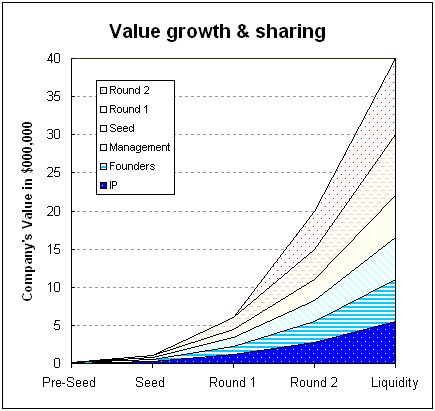Finance for Start-Up
Growth of Company Value & Sharing Risks and Returns
Typical business development & equity scenario
Raising early stage financing is a vital, long and intensive process. Unfortunately, there is no single type of financing appropriate for all start-up companies and no single path to accessing money. Each new venture must design its own strategy for obtaining financing depending on the development stage, the industry in which it operates, the size of the market opportunity and other specific financing requirements.
Seek professional assistance early! This help will keep you on track through the many stages of pursuing financing.
Before calling potential investors, you should complete a business plan, identify possible investment sources and create an investment proposal. See Methods of Financing your Business (.doc) for more detailed information on this topic. Next, consider making initial contact with target investors just to introduce your company. Then prepare a very polished presentation for the target investors. Following-up on the previous contact, request an opportunity to present.
 |
Outside investors will want to know the full story on your company before any investment. Be prepared to “open your books” and provide references. |
|
| |
 Typical Start-Up Financing Includes:
Typical Start-Up Financing Includes:
- “Love Money” – Family and Friends
- Public Funding Agencies (usually government programs)
- Tax Credits
- Angel Investors
- Venture Capitalists
- Strategic Investors/Partners
|
|
After the initial pitch, if you are one of a select few companies, your company will face a due diligence review. Passing due diligence leads to a term sheet and negotiation on the terms of financing. Finally, after considerable work, you will be able to close the deal. The earlier you secure professional assistance with these stages, the smoother the process.
 |
‘Who has legal claim to the technology? What kind of claims exist?'
- The first questions most investors ask. |
|
You must be able to answer the questions on technology ownership clearly and unambiguously. Technology originating in the university research environment requires a clear understanding and determination of the university's position with respect to the technology.
| Growth of Company Value & Sharing Risks and Returns |
|
The collaborative partnership of all parties involved in a company's development is key to the company's value growth. This also implies sharing risks and returns among the parties.
The graph below summarizes how the value of a hypothetical company grew and is shared by the parties.
It is important to realize that although initially the company did not have any assets except the Intellectual Property (IP) and it was owned by the IP holders and the founders, at the end, both the IP holder's and the founders' portions are diluted to relatively small minority positions (13% each, in our example).

Figure 4. Company's value growth and sharing among various stakeholders.
| Typical business development & equity scenario |
|
This example is for illustration purposes only. Actual numbers will differ.
Pre-Seed Stage |
|
|
|
IP |
= |
50% |
(1/3 inventors = 16.67%: 2/3 UA = 33.33%) |
Founders |
= |
50% |
Up to $50K |
|
|
|
Founders, family, friends or government money
Incorporation, set-up, draft business plan |
|
|
|
|
Seed Round |
$250K for 25% + 25% to key management |
IP |
= |
25% |
(Inventors = 8.33%: UA = 16.7%) |
Founders |
= |
25% |
|
Seed money |
= |
25% |
for approximately $250K |
Management |
= |
25% |
Key management (CEO, CTO, CFO, CBDO, etc) |
| |
|
|
|
|
|
|
Detailed Business Plan, establish office
Value = $1 million |
|
|
|
|
1st Round |
$1.5 million for 25% |
IP |
= |
18.75% |
(Inventors = 6.25%: UA = 12.50%) |
Founders |
= |
18.75% |
|
Seed |
= |
18.75% |
|
Management |
= |
18.75% |
|
1st Round money |
= |
25% |
for $1.5 million |
|
|
|
|
|
|
|
Expand management team, first milestone
Value = $6 million |
|
|
|
|
2nd Round |
$5 million for 25% |
IP |
= |
13.75% |
(Inventors = 4.58%: UA = 9.17%) |
Founders |
= |
13.75% |
|
Seed |
= |
13.75% |
|
Management |
= |
13.75% |
|
1st Round |
= |
20.00% |
|
2nd Round |
= |
25.00% |
for $5 million |
|
|
|
First product, expanded team, milestones
Value = $20 million |
| |
|
|
|
Liquidity event
The Company successfully implements its business plan. It is valued, for instance, at $40 million based on its revenue and profit. A liquidity event must take place in order for the investors to get their money out, hence the Company is going public or being acquired.
The relative ownership is the same as after 2nd Round of financing and absolute values of shares are: |
|
|
|
|
IP |
= |
$5.5 million |
(Inventors = $1.83 million: UA = $3.67 million) |
Founders |
= |
$5.5 million |
|
Seed |
= |
$5.5 million |
|
Management |
= |
$5.5 million |
|
1st Round |
= |
$8 million |
|
2nd Round |
= |
$10 million |
|
|
|
|
Commercial success, Liquidity event
Value = $40 million |
Back to Top
|

















